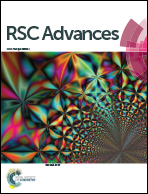Three dimensional manganese oxide on carbon nanotube hydrogels for asymmetric supercapacitors†
Abstract
In this article, we report the development of manganese oxide (Mn3O4) on carbon nanotube (CNT) hydrogels as binder-free electrodes for asymmetric supercapacitors. The CNT hydrogels consisting of three dimensionally inter-connected nanotubes are prepared via a facile sol–gel method. Afterwards, flower-like Mn3O4 is incorporated into CNT hydrogels using a pulse electrochemical deposition. Satisfactory electrochemical performance with a high specific capacitance of 182 F g−1 (473 mF cm−2) is achieved. When employing activated carbon as negative electrodes, the assembled asymmetric supercapacitor exhibits a high potential window of 2 V to reach a specific energy of 26.6 W h kg−1 and a specific power of 5.2 kW kg−1. These results are much better compared with the results from pure Mn3O4. The remarkable performance of our composites can be ascribed to a highly conducting CNT micro-scaffold and pseudocapacitive Mn3O4.


 Please wait while we load your content...
Please wait while we load your content...